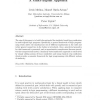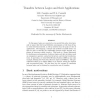345 search results - page 37 / 69 » Kripke models for classical logic |
EUSFLAT
2001
13 years 9 months ago
2001
The aim of this paper is to build a formal model for similarity-based fuzzy unification in multi-adjoint logic programs. Specifically, a general framework of logic programming whi...
ISOLA
2007
Springer
14 years 1 months ago
2007
Springer
We present a model of the IEEE 1394 Root Contention Protocol with a proof of Safety. This model has real-time properties which are expressed in the language of the event B method: ...
SLOGICA
2002
13 years 7 months ago
2002
In this paper, logics are conceived as two-sorted first-order structures, and we argue that this broad definition encompasses a wide class of logics with theoretical interest as w...
ICMCS
2006
IEEE
14 years 1 months ago
2006
IEEE
Automatic facial expression analysis is an important aspect of Human Machine Interaction as the face is an important communicative medium. We use our face to signal interest, disa...
RV
2007
Springer
14 years 1 months ago
2007
Springer
When monitoring a system wrt. a property defined in some temporal logic, e. g., LTL, a major concern is to settle with an adequate interpretation of observable system events; that...


